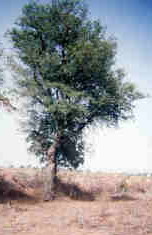Prosopis cineraria
Prosopis cineraria, commonly known as Ghaf, is a species of flowering tree in the pea family, Fabaceae. It is native to arid parts of Western Asia and the Indian Subcontinent, including countries such as India, Pakistan, Iran, Oman, Yemen, and the United Arab Emirates. This tree plays a significant role in the ecology of these desert environments and is culturally significant in many communities.
Description[edit | edit source]
Prosopis cineraria grows as a medium-sized tree, typically reaching heights of 15 to 25 feet. It has a deep taproot system that allows it to access water from deep underground, making it well-adapted to life in arid conditions. The tree's leaves are small, compound, and deciduous, providing shade and contributing to its role as a key species in its ecosystem. The flowers are small, yellow, and fragrant, appearing in clusters. These are followed by seed pods that contain several seeds, which are an important food source for local wildlife.
Ecological Role[edit | edit source]
The Ghaf tree plays a crucial role in its ecosystem. It acts as a natural soil stabilizer, preventing soil erosion with its extensive root system. It also provides shade and lowers ground temperatures, creating microhabitats that support a variety of plant and animal species. In addition, the tree is a vital source of fodder for livestock, particularly in times of drought when other food sources are scarce.
Cultural Significance[edit | edit source]
In many cultures within its native range, Prosopis cineraria holds significant cultural and economic value. It is often found in community gathering places and is associated with various cultural and religious practices. In some regions, it is considered sacred and is protected by local communities. The tree's wood is used for fuel and construction material, while its pods are used as fodder and sometimes as food by local populations.
Conservation[edit | edit source]
Despite its resilience and adaptability, Prosopis cineraria faces threats from overgrazing, habitat destruction, and climate change. Efforts are being made to conserve this species through sustainable management practices, protection of natural habitats, and reforestation projects. Its importance to both the environment and local communities makes it a priority for conservation efforts in its native range.
See Also[edit | edit source]
Prosopis cineraria[edit | edit source]
Search WikiMD
Ad.Tired of being Overweight? Try W8MD's physician weight loss program.
Semaglutide (Ozempic / Wegovy and Tirzepatide (Mounjaro / Zepbound) available.
Advertise on WikiMD
|
WikiMD's Wellness Encyclopedia |
| Let Food Be Thy Medicine Medicine Thy Food - Hippocrates |
Translate this page: - East Asian
中文,
日本,
한국어,
South Asian
हिन्दी,
தமிழ்,
తెలుగు,
Urdu,
ಕನ್ನಡ,
Southeast Asian
Indonesian,
Vietnamese,
Thai,
မြန်မာဘာသာ,
বাংলা
European
español,
Deutsch,
français,
Greek,
português do Brasil,
polski,
română,
русский,
Nederlands,
norsk,
svenska,
suomi,
Italian
Middle Eastern & African
عربى,
Turkish,
Persian,
Hebrew,
Afrikaans,
isiZulu,
Kiswahili,
Other
Bulgarian,
Hungarian,
Czech,
Swedish,
മലയാളം,
मराठी,
ਪੰਜਾਬੀ,
ગુજરાતી,
Portuguese,
Ukrainian
Medical Disclaimer: WikiMD is not a substitute for professional medical advice. The information on WikiMD is provided as an information resource only, may be incorrect, outdated or misleading, and is not to be used or relied on for any diagnostic or treatment purposes. Please consult your health care provider before making any healthcare decisions or for guidance about a specific medical condition. WikiMD expressly disclaims responsibility, and shall have no liability, for any damages, loss, injury, or liability whatsoever suffered as a result of your reliance on the information contained in this site. By visiting this site you agree to the foregoing terms and conditions, which may from time to time be changed or supplemented by WikiMD. If you do not agree to the foregoing terms and conditions, you should not enter or use this site. See full disclaimer.
Credits:Most images are courtesy of Wikimedia commons, and templates, categories Wikipedia, licensed under CC BY SA or similar.
Contributors: Prab R. Tumpati, MD





